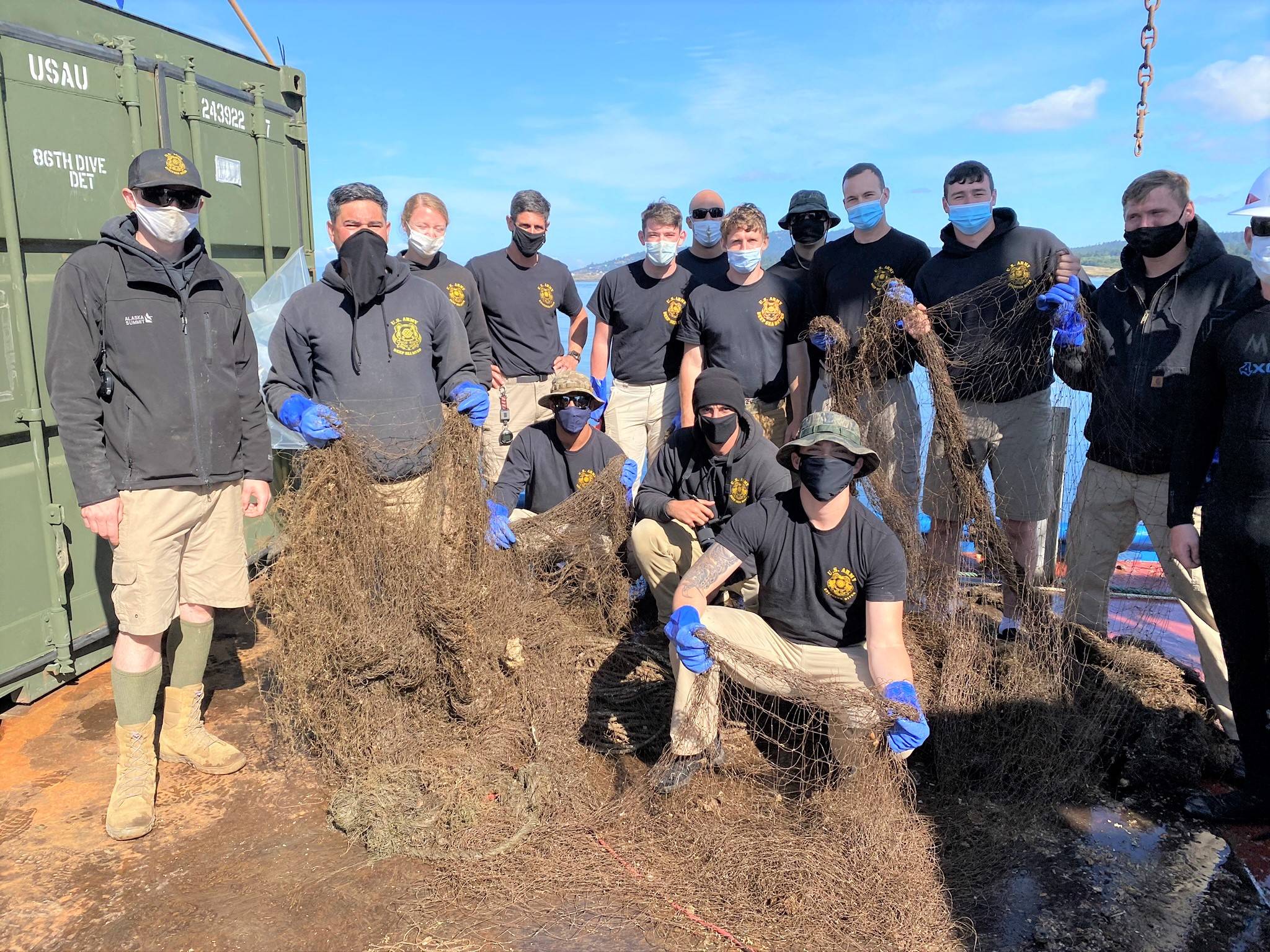Deep beneath the waves off the south end of San Juan Island, long lost gillnets sway gently in the current, ensnaring fish and other marine life. Last year, the United States Army’s 569th Engineer Dive Detachment trained and removed seven nets. This year the 86th Engineer Detachment Army divers pick up where the previous team left off.
“We have 53 targets,” Joan Drinkwin, principal contractor for Natural Resources Consultants, said. “Many of these targets might represent a single net. Last year about 33 targets were 5 nets. This year we are hoping for a similar result.”
Training and removal began July 6 and is currently underway and is set to conclude July 24.
Natural Resource Consultants is a company that is working with the Washington State Department of Natural Resources and the Northwest Straits Initiative to remove abandoned fishing gear. The derelict net removal program began in 2002. As of 2016, the latest available data, the team had removed nearly 6,000 nets from Puget Sound. Those nets contained 298,383 different types of animals from birds to fish to mammals. The nets were shown to be impacting 255 different species of animals.
In San Juan County, they have retrieved 2,224 nets in shallow waters up to 100 feet deep. Those nets contained 494,939 animals: 81 were mammals, like otters, seals and porpoise; 1,249 were birds; 5,839 were assorted fish, including some endangered species; and the rest of the bycatch consisted of invertebrates.
Because the deepwater nets are remnants from the 1950s and ‘60s, they were made from heavier material than modern nets according to United States Army’s 569th Engineer Dive Detachment Commander Tyler LeRoy. The largest gill net collected was made out of heavier material, LeRoy told the Journal, and weighed approximately 8,000 pounds.
“We started pulling, and it just kept coming,” LeRoy told a crowd with a laugh during a July 2019 thank you event.
There are 195 known deepwater derelict fishing nets — meaning they are below 105 feet depth — throughout Puget Sound. Due to the depth, the water’s temperature and its current, these nets are costly to remove according to Drinkwin. In an innovative, win-win partnership, Natural Resources Consultants and DNR has joined with the United States Army, which has soldiers in need of dive training. This joint effort called the Army Deepwater Derelict Net Removal Project utilizes army divers to collect deepwater derelict nets. The Army provides the divers, the decompression chamber and other necessary dive equipment. The Army is also contracting with Northern Marine, a local contractor, to supply the work vessel. WADNR arranges for disposal of the removed gear and is also paying for local project management. In-kind donations, according to Drinkwin, cover for those costs.
“This project is made possible by funding from the Washington Department of Natural Resources and support from the Department of Defense Innovative Readiness Training program,” Drinkwin said.
The seven nets removed by the United States Army’s 569th Engineer Dive Detachment covered 0.28 acres and contained more than 200 living and dead animals. Among the species entangled were one live black rockfish; three dead lingcod; 36 dead smooth pink scallops; and 10 live smooth pink scallops.
The soldiers completed approximately 40 dives last summer.
“That might not sound like a lot, but depths of 152 feet, like what we were doing, the dives have to be short,” LeRoy told the Journal, adding that if a diver were to become tangled for as few as five minutes, they could die.
While the site has not been revisited, Drinkwin said, it generally only takes one year for the habitat to recover once nets are removed.
Since the dive work takes place where Southern resident orcas frequent, the Deep Water Derelict Net Removal program’s website states that the crew follows Whale Wise guidelines at all times and that during diving operations, vessel engines are turned off.
The Coast Guard is present this year, for additional support to the 18 member 86th Engineer Detachment Army divers.
The COVID-19 pandemic brought an additional challenge this year, according to Drinkwin. The A full COVID prevention and mitigation plan that was consistent with Gov. Jay Inslee’s guidelines under Phase Two was developed. Everyone receives a health check before boarding, masks are required when social distancing is not possible, and cleaning high touch areas has also been ramped up. To ensure easy contact tracing, should that be necessary, a roster is also being kept. The Army is sanitizing dive helmets after each dive and restricting vehicle occupancy during transit. Unlike last summer, no volunteers or visitors are allowed on board. Interested parties will need to view the boat from shore.
An estimated 15-30 gillnets are lost annually, according to Drinkwin. As per RCW 77.12.870, boaters are required to report lost equipment like nets or crab pots within 24 hours so they may be quickly retrieved. Drinkwin added that most of the nets being removed, like the ones located off San Juan Island’s southend, were lost as many as 60-70 years ago, during the height of salmon gillnetting.
“Current loss is low, due to the newly lost net Reporting Response and Retrieval Program to minimize harm from lost nets by retrieving them as soon as possible” Drinkwin said.
Drinkwin has worked frequently with Washington Tribes as well. Most fishing tribes have their own requirements, according to Drinkwin, and fully cooperate with the Reporting, Response and Retrieval program to prevent damage from newly lost fishing nets.
“This program is an international model,” Drinkwin said.




